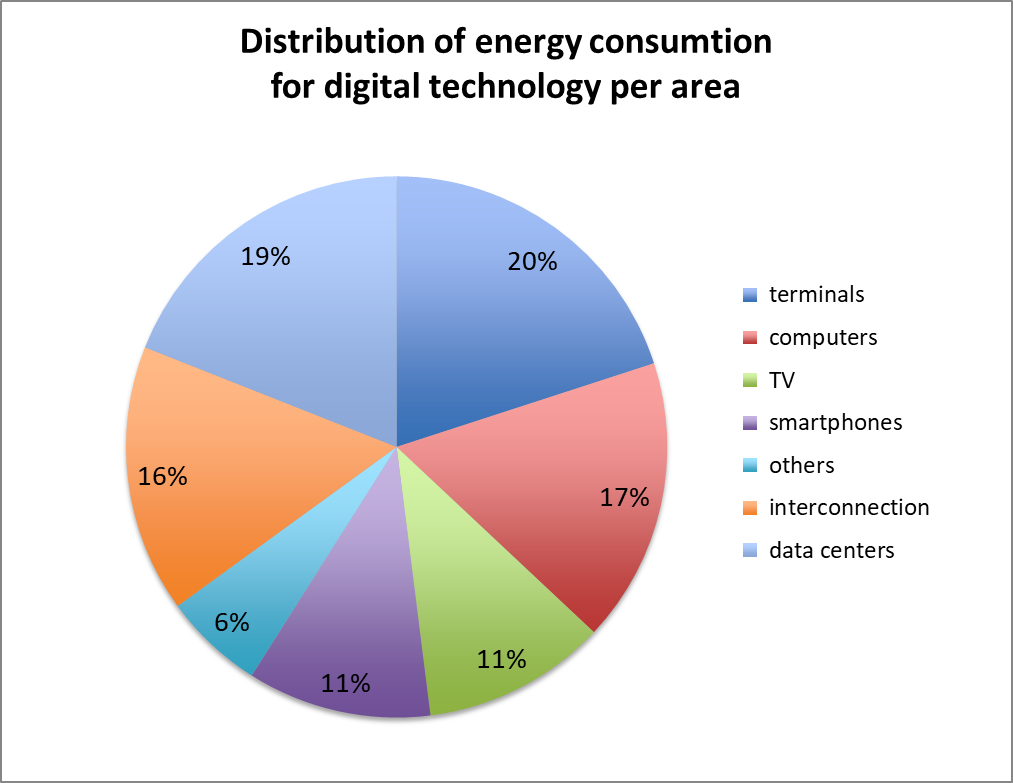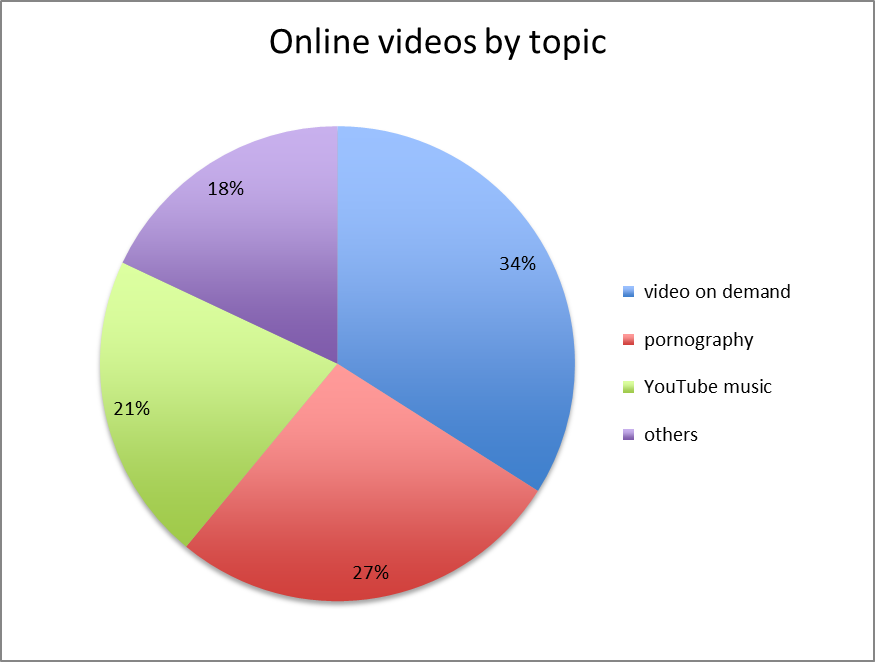Online videos and emails generate tons of CO2
Excessive digitalisation needs considerable amounts of energy
by Yohan Blavignat, journalist
Day by day online videos are increasingly replacing DVDs, bank transfers are replacing checks or letters are being sent as e-mails. Although invisible, the impact of dematerialisation on our planet is considerable. “Le Figaro” has published the crazy figures of “digital pollution” and suggests a few ways to limit them.
It is everywhere now. Every day, billions of people around the world use it without realising it. Dematerialisation is in our mobile phones, in all kinds of magnetic cards, computers, watches and sometimes even in our clothes. This concept has also become a selling point because it protects the environment. Valérie Pécresse, President of the Île-de-France region, took this position with pride when introducing the Navigo Easy magnetic card in early June, as it replaces the paper tickets on the Paris metro, which, as a result of the pollution they cause, are considered from “another century”. 500 million tickets are discarded every year. But is the choice of dematerialisation – and with it the constant expansion of digital technology – really the solution to the environmental crisis that is shaking the planet?
In collective thinking, dematerialisation is a fairly simple concept. It consists of converting all paper documents into digital versions. According to the “Lexicon of Sustainability”, dematerialisation means “drastically reducing the amounts of material caused by human action”. There is nothing simpler in theory: we scan paperwork, download films or music, we whip out our tube ticket at an electronic terminal, etc. And we have to confide in storage devices to secure this digitised data. So the goal is to limit the consumption of paper or plastic. From now on, letters will no longer – or only very rarely – be sent by post. We prefer e-mail. We hardly issue checks anymore, we use electronic bank transfers. We no longer buy DVDs or CDs, we download them or watch them via streaming. And so our consumption patterns have developed at a rapid pace in recent years to focus on digitisation.

Worrying figures
While dematerialisation promises the gradual elimination of paper, excessive digitisation consumes a considerable amount of energy. According to the report “Towards digital sobriety” published in October 2018 of the think tank The Shift Project, ultra-fast growth of digital technology is leading to an “alarming” result posing a risk to climate and natural resources. The authors state that “there is a real risk of a scenario in which increasingly massive investments in digital technologies would contribute to a net increase of digitalised sectors’ carbon footprint”. “Digital transition as it is implemented at present is more involved in climate change than it helps to prevent it,” experts warn. These conclusions are in line with the recommendations of the White Paper “Digital and Environment” published in March 2018 by the Institute for Sustainable Development and International Relations (IDDRI), FING (the Next generation internet foundation), WWF and GreenIT.fr.
The extensive increase in digital technology and all its applications in everyday life threatens our planet in the long term. Although fossil fuels account for 80% of global energy consumption, their share is declining in favour of digitisation. Thus, energy consumption of digital technology is increasing worldwide by almost 9% per year, experts warn. What is worse, the share of digital technology in greenhouse gas emissions has risen by almost half since 2013, from 2.5% to 4% of total global emissions, which is more than that of civil aviation. This share could double by 2025 and then reach the current share of emissions of all passenger cars. Technological development is just exacerbating this phenomenon. The production of iPhone 6, which allows even more data to be stored than its predecessors, generates almost four times more greenhouse gases than the iPhone 3GS, especially since the number of smartphones is expected to rise from 1.7 billion in 2013 to 5.8 billion in 2020. This corresponds to an annual growth rate of 11%.
Another daily activity has considerable negative effects on the environment. Even though it may seem harmless at first glance, sending e-mails is very energy-intensive. According to a report by the Radicati Group, around 225 billion e-mails are sent every day. The French Environment and Energy Management Agency ADEME (www.ademe.fr) estimates that each French employee receives an average of 58 professional e-mails per day and sends 33.
According to the agency, sending these 33 e-mails to two recipients, accompanied by one million attachments, causes annual emissions of 180 kg CO2 or up to 1,000 kilometres by car. According to this calculation, the e-mails sent by a company with 100 employees would emit 18 tonnes of greenhouse gases annually, equivalent to 18 return flights Paris-New York. According to ADEME, these emissions come from “power consumption of your computer”, and above all from “power consumption of IT installations and equipment in the data centres (such as air conditioning)”. More than 4,000 of these data storage centres are listed worldwide, 141 of which are in France, according to the Data Center Map website. Worldwide, they alone consume almost 30 billion watts per year, representing 4% of global energy consumption.

Online video – the black sheep
Watching online videos (so called “streaming”) is one of the greatest environmental threats; according to a warning published in the report of The Shift Project of 11 July 2019, an invisible and indescribable pollution, annually generating 300 million tonnes of CO2, equivalent to the entire greenhouse gas emission of Spain or nearly 1% of the global emissions. Stored in data centres, the video is sent to our computer terminals, smartphones TVs etc. via networks (cable, glas fibre, modems, mobile telephony antennas etc.). All these processes require electricity, the production of which consumes resources and usually emits CO2. Anyone who believes that switching from DVD and VHS to online videos, that get lost in the data stream and the digital “cloud”, would have a positive impact on the environment has himself to be put right.
Another alarming fact is that ten hours of a high-definition (HD) film comprise more data than the entirety of the English Wikipedia articles (more than two million). Specifically, pornographic videos constitute 27% of the entire global online video consumption. In 2018 they alone generated more than 80 million tonnes of CO2, an equivalent to the emissions of the entire house building industry in France. The greenhouse gas emissions of video-on-demand services (Netflix, Amazon Prime …) are equivalent to those of a country like Chile.
According to Hugues Ferreboeuf, project director of the working group “Lean ICT” for “The Shift Project”, our digital consumption is unsustainable in the long run. He takes a stand for the introduction of “digital soberness” in order to decrease the impact of global warming. “This report shows that most of the videos, which constitute 80 % of the internet traffic, are consumed for entertainment or advertising purposes. Considering the climate crisis, this observation should convince us that questioning our digital activity is not only desirable but also possible”, he stresses to Le Figaro.
How can we “green” the digital world?
In order to decrease the carbon footprint of the dematerialisation, radical changes in our lifestyle are required. Hugues Ferreboeuf from the think tank “The Shift Project” demands a “digital soberness” aiming “to make the digital system more robust”. To this end, he advocates for a less frequent renewal of devices: “We can very well change our smartphones only every three years instead of each year”, but also watch fewer videos or select them more carefully. “As an individual one should stay digitally sober when consuming online videos. It’s about using the lowest possible definition, reducing consumption or selecting more thoroughly what to watch”, he explains.
From an institutional perspective the telecommunication companies could “install a digital CO2 meter in their boxes”, he continues, “in order to calculate each user’s CO2 footprint”. “In the past we used to have a time-limited internet access with our fixed rates. Nowadays it is unlimited, due to tough competition between the providers. But this is human: the more you can surf the internet and watch videos the more you deploy it.” Hugues Ferreboeuf demands a sensitising campaign from the authorities, like the one on tobacco consumption. “In my opinion, our way of using the internet must be reconsidered from scratch and doing so completely cover the ecological effects.”
For, any reduction of those negative ramifications of digital technology on the environment requires political intent. Digitisation is constantly evolving and the number of interconnected objects keeps increasing. “If there are one million of autonomous vehicles floating around the globe tomorrow, the volume of data traffic on the internet will duplicate. That’s remarkable”, Hugues Ferreboef emphasises and he wonders: “To what extent should we put modern conveniences and leisure before the future of mankind?” In the future, everyone must become aware of this. •
Source © Yohan Blavignat/Le Figaro 13 July 2019
(Translation Current Concerns)